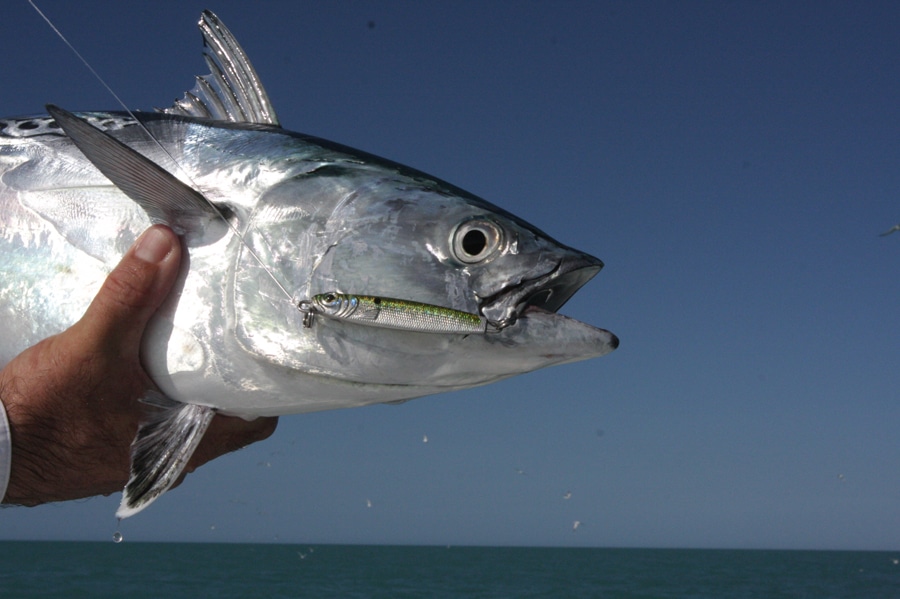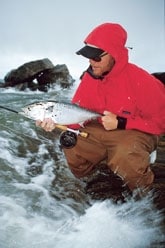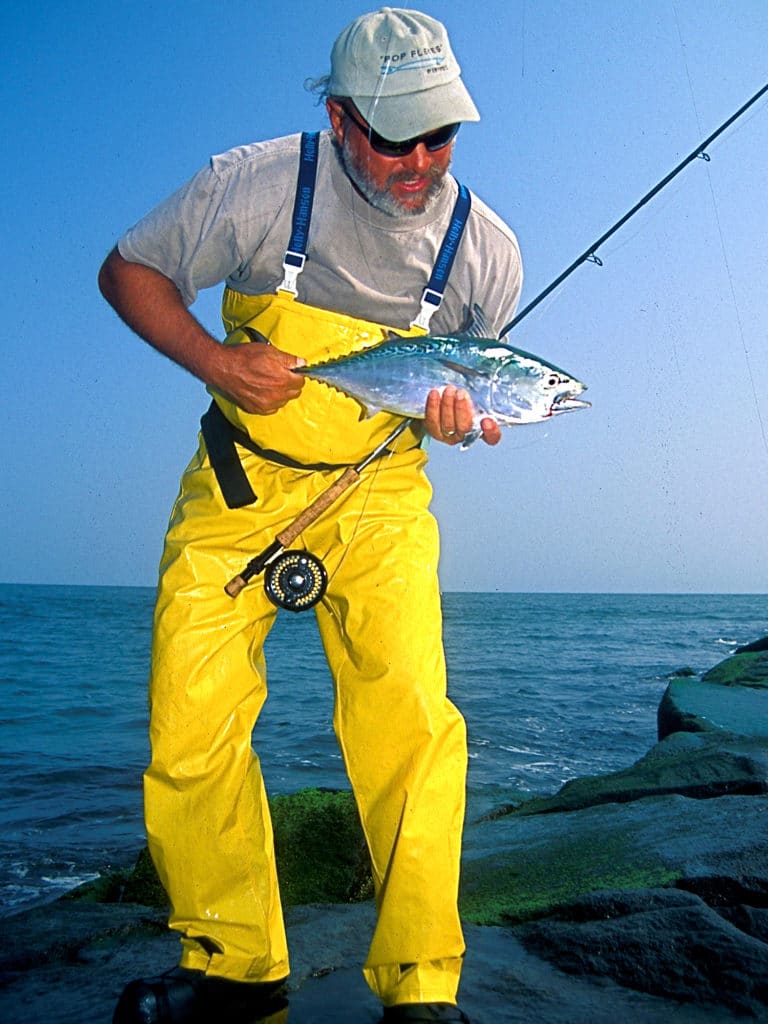
Generally categorized as an offshore fish, bluefin tuna have been known to feed near shore on rare occasions. In fact, years ago, my brother and I found a bluefin, about 80 pounds, on Nauset Beach on Cape Cod while fishing on a fall morning. The fish must have been hooked from shore and worn the bottom half of its tail to a nub as it circled in the shallows. It was still fresh with blood flowing from its gills. We loaded it onto the front rack of my beach buggy and drove back to town. The looks we got driving along Route 6 were priceless.
There are, however, predictable inshore runs of ocean fish. They aren’t bluefin but can still smoke a reel drag. There is something special about catching ocean fish from shore — fish that have lived some portion of their lives in deeper, blue water. Along both the Atlantic and Pacific coasts there are several species of tuna-like fish that provide thrilling action for shore-bound anglers.
California Bonito Fishing
On the west coast, Pacific bonito, also called “bones,” keep California anglers happy. Most fish range in size from three to seven pounds — a ten-pound fish is big. Fishing starts in early summer, but the first action requires a boat. July marks the beginning of the run with the peak time in late summer into early fall. Runs of fish linger through October. Harbors and other locations with rock walls and jetties are good places to find these speedy sport fish along the California coast. The jetties and walls are key to this fishery because they hold baitfish.
Pacific bonito seldom feed along beaches as do their east coast cousins. Harbors, bays or sheltered locations, such as King Harbor in Redondo Beach, Mission Bay in San Diego, and the seawall at Long Beach are a few hot fishing locations and typically feature good concentrations of the bonito’s favorite food: anchovies. These baits are three to five inches long with green backs.
Bonito Fishing in the Atlantic

East Coast anglers can target two species of speedsters: Atlantic bonito and the little tunny, also called false albacore or albie. Atlantic bonito are similar in size to their Pacific cousins. Albies are bigger, five to ten pounds, but a good fish can weigh 13 to 15 pounds. Off the Outer Banks of North Carolina, fish in the high teens are possible.
In the Northeast, warm weather and water produce the best action. Atlantic bonito fishing starts along the shore in late July to early August but peaks in September. False albacore usually show in late August to early September with late runs going well into October. Off the Outer Banks of North Carolina, albacore runs usually peak in November and continue into December. Because bay anchovies are a major food source, lures with metallic-green backs and a silver-white underside are most effective. Flyfishermen should use small tan or light-olive anchovy patterns measuring two to 3 1/2 inches long.
If I had one favorite location to fish for both albies and bonito, it would be Martha’s Vineyard in Massachusetts. A top pick for just albies would be the Outer Banks from Cape Hatteras to Cape Lookout and the west side of the beach at Great Point on Nantucket. Anglers can find good runs along some beaches and around most inlets from the south side of Cape Cod in Massachusetts, to Cape May, New Jersey, and south. The Outer Banks of North Carolina at Harkers Island are the boat-angler’s Mecca for albacore. But good shore fishing is available from both the beaches and around the inlets. Several key locations are Cape Lookout and Cape Point at Hatteras. Most beaches offer good access for four-wheel-drive vehicles.
How to Catch Bonito

Fishing logic that shore anglers use to catch other inshore species doesn’t always work when dealing with the tuna-like fish. Depending on the location, they can be picky or even downright difficult to catch. Here’s how to improve your hookups:
- Don’t chase the fish: Pick a spot where fish continue to pop up and keep fishing it. When fish are busting along a beach, jetty wall or channel, cast in front of of the school.
- At times there will be fish ahead of the school not showing on the surface, but they are hot to take.
- Narrow down the search: Look for smaller places or locations that collect fish in one spot. Jetties along small inlets, small channels and edges with a strong flow that have good concentrations of feeding fish are ideal places to cast a lure or a fly.
- Choose tackle to fit conditions: This is especially critical for fly fishermen. A 10-weight is a good choice when fishing a strong flow that runs a good distance. In smaller locations with bonito, eight- and nine-weight outfits are ideal.
- A clear intermediate fly line will fish most conditions.









